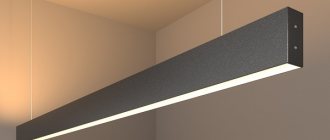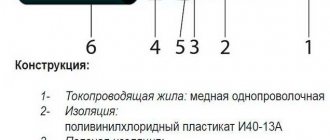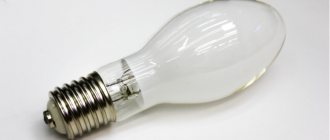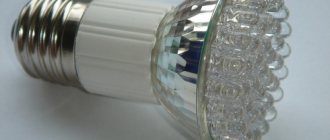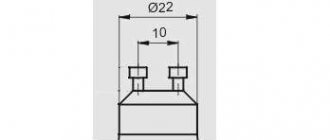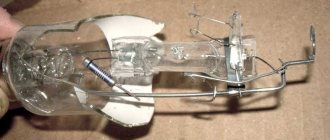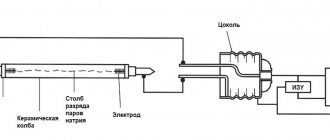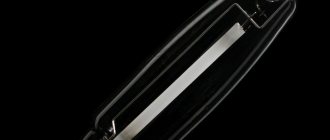The study of the behavior of electric discharge in various environments with the aim of creating a light source has been carried out since the end of the 19th century by scientists from many countries around the world. The first low-pressure mercury lamp, the design of which is almost identical to the modern one, was created in 1901 by engineer Peter Cooper-Hewitt. But it was only in 1938 that General Electric began serial production of fluorescent lamps.
In the USSR, such lamps first appeared in 1951, thanks to the efforts of a team of engineers led by physicist Valentin Aleksandrovich Fabrikant. The 36 W fluorescent lamp is one of the most popular lighting products. It is simple, cheap and reliable.
Design features and principle of operation
Fluorescent lamp 36 W
A 36 W lamp is an ordinary glass tube, the ends of which are sealed. The inside of the flask is treated with a special agent - a phosphor, which converts the resulting ultraviolet radiation into visible light. The tube is also filled with a mixture of argon and mercury gases. First, all the air is pumped out of the pipe. The current passes through a tungsten helix, which is coated with oxides to increase reliability. Nickel electrodes are connected to the ends of the spiral.
In order for the light bulb to light up, you need to apply an electric current. It increases the temperature of the coil, which causes a discharge. The resulting ultraviolet passes through the phosphor and the walls of the flask and turns into visible radiation at the output.
Inside the flask there is a mixture of different gases and vapors, which is plasma. It emits a stream of light in the visible and invisible regions of the spectrum. The phosphor converts invisible radiation into visible radiation, and as a result, the lamp can illuminate a certain area.
Thanks to this design and improved materials, the light bulb will consume less electricity than conventional lamps. If compared with an incandescent lamp, the amount of energy required will decrease several times.
Fluorescent lamp device
Principle of operation
These lamps use mercury; when heated, an electrical discharge is created in the vapor of this metal, which contributes to the formation of ultraviolet radiation. Further, a special substance called phosphor absorbs this radiation, resulting in light being produced in a spectrum familiar to the human eye. This is how it should be ideally. In fact, the shade of lighting is constantly criticized by users of these lamps precisely for the unnatural color. You can philosophize a little about physical laws, remember that from this point of view, color does not exist without light at all, and therefore, from the point of view of this science, fluorescent lamps really paint everything in natural colors. Basically, all this is nitpicking. The shades of the illuminated objects do not change so much as to seriously perceive this moment as an inconvenience (except for certain specific areas of activity), and the savings in comparison with traditional ones are very noticeable.
Types of fluorescent lamps
Any luminescent devices can be divided into two groups:
- General purpose lamps. These include lamps with power from 15 to 80 W.
- Special purpose. These include devices up to 15 W and over 80 W. They are called low-power and high-power, respectively.
General purpose lamps provide natural light.
Shapes of bulbs of compact fluorescent lamps
Devices can also be divided according to a number of technical indicators:
- According to light discharge: arc and smoldering.
- By radiation: with natural light, ultraviolet and different colors.
- According to the shape of the flask: linear tubes and curly models.
- Along the length of the tube.
- According to the base used: 14 mm and 27 mm.
- According to the distribution of light flux: directional and non-directional.
Types of illumination depending on the color temperature of light
Classification by color temperature:
- 2700-3400 K. These are warm shades. They have a calming and relaxing effect, which is why they are often placed in bedrooms.
- 3400-5600 K. Give natural radiation. Suitable for living rooms, kitchens and other types of rooms.
- 5600-6400 K. Cold tones. They increase tone and performance, which is why they are used in offices.
A 36 W luminescent source is analogous to a 40 W device. This is due to the fact that modern technologies allow the use of higher quality, reliable and modern materials.
Energy-saving devices use a high-quality phosphor layer and an improved design of the electrode block. Thanks to all these features, fluorescent light bulbs with lower wattage have a higher effective luminous flux. It is important to note that the tube diameter is reduced by 1.6 times.
Color rendering
The color rendering of light bulbs directly depends on the light temperature parameter, measured in Kelvin. Thus, the following limits of values can be distinguished:
- from 2700 to 3400 kelvins produce warm shades of light;
- from 3400 to 5600 kelvins allow you to get natural shades;
- 5600 to 6400 Kelvin produces cool tones.
These parameters directly affect human performance. In offices, it is customary to use luminaires with cold light, as they have a better effect on a person when working. Warm light, on the contrary, relaxes and calms, which is why it is preferable to install it in bedrooms or hospital wards.
Marking of light sources
Lamp markings
The 36 W fluorescent lamp has simple letter and number markings. For example, a 36w fluorescent lamp with the abbreviation LB-36 is deciphered as follows:
- L – lamp.
- B – white color.
- 36 – power, W.
There are also 36W fluorescent lamps with different markings:
- LTB. Warm white light. They have a barely noticeable pink tint.
- LD. Close to daylight.
- LDC – fluorescent lamps with different colors.
- LCB – cool white.
The given markings are used in Russian products. Foreign designation is different. It consists of three numbers and English words indicating the type of glow. Labeling may differ between different foreign manufacturers.
LB products are the most efficient in terms of output luminous flux compared to other devices of the same power.
Specifications
Characteristics of fluorescent lamps of the LB series
36 watt lamp has the following characteristics:
- radiation brightness 6-11 cd/sq.m;
- ripple factor 23%;
- brightness and power increases with increasing rated voltage;
- service life from 4800 hours, average value is 12000 hours;
- base G13;
- flask diameter 26 mm;
- length of most part 12 cm;
- rated voltage 103 V.
The data given are average values. They may vary between different manufacturers and under specific operating conditions. The service life can be significantly reduced due to frequent switching on and off or high room humidity and low temperature. Therefore, it is important to choose the right location for installing the light source.
(tube diameter - 26 mm)
| Halogen lamps: 105 photos of modern types, features of their operation and scope of application Designation | W | Base | R Lm | Ra | ||
| Osram | Philips | G.E. | ||||
| — | TL-D 18W/54 | F18W/54 | 18 | G13 | 1050 | 76 |
| L18/20 | TL-D 18W/33 | F18W/33 | G13 | 1150 | 62 | |
| L18/25 | — | F18W/35 | G13 | 1100 | 75 | |
| L18/30 | TL-D 18W/29 | F18W/29 | G13 | 1150 | 50 | |
| — | — | F18W/25 | G13 | 1100 | 73 | |
| — | TL-D 36W/54 | F36W/54 | 36 | G13 | 2500 | 76 |
| L36/20 | TL-D 36W/33 | F36W/33 | G13 | 2850 | 62 | |
| L36/25 | — | F36W/35 | G13 | 2600 | 75 | |
| L36/30 | TL-D 36W/29 | F36W/29 | G13 | 2850 | 50 | |
| — | — | F36W/25 | G13 | 2600 | 73 | |
| — | TL-D 58W/54 | F58W/54 | 58 | G13 | 4000 | 76 |
| L58/20 | TL-D 58W/33 | F58W/33 | G13 | 4600 | 62 | |
| L58/25 | — | F58W/35 | G13 | 4100 | 75 | |
| L58/30 | TL-D 58W/29 | F58W/29 | G13 | 4600 | 50 | |
| — | — | F58W/25 | G13 | 4100 | 73 |
Fluorescent lamps with improved color rendering. (tube diameter - 26 mm).
Advantages and disadvantages
Fluorescent devices are inferior to LEDs, but are still often used for illumination. This is due to the positive qualities of a 36 W fluorescent light bulb:
- small dimensions and weight;
- wide scope of application;
- saving;
- large coverage area;
- extended spectrum of light;
- long service life;
- good efficiency;
- availability of analogues for various purposes and colors.
Light bulbs also have disadvantages:
- the presence of harmful substances in the device;
- difficulty of disposal;
- harm to human health and eyes;
- requires throttle to start;
- increase in cost;
- long startup;
- reduced service life due to frequent switching on and off.
The devices are actively used and replace outdated incandescent lamps and halogen devices.
Areas of application
Fluorescent lamps in an industrial workshop
Fluorescent lamps have a wide range of uses. They can create all types of lighting in residential premises, offices, fill industrial premises with light, and create illuminations.
The devices have also found their application in medicine. Using special fillers, bactericidal and ultraviolet lamps can be created. They are used to clean the room from bacteria and germs. Lamps can also be installed in shops, warehouses and enterprises for the purpose of disinfecting premises.
The ability to create sources of different colors has led to the use of fluorescent light bulbs in entertainment, show business, and advertising.
Recommendations for selection
Fluorescent lamps osram L 36W/60
Lamps are selected for a specific type of lamp. This obliges the buyer to pay attention to its characteristics. Particular care should be taken when choosing fluorescent lamps. For example, the Russian lamp LB 36 has a length of 1200 mm and is suitable for installation in a corresponding device. A 35 W device of similar power from the German company OSRAM has a different length - 1449 mm. The length of the tube must be taken into account when purchasing.
Attention is also paid to the diameter of the flask. The standard is 16 mm, but you can find devices for 12 mm, 25 mm and other sizes. The luminous flux directly depends on the diameter. In lamps you can use a tube with the same base (G13) with a smaller diameter, but not with a larger one.
Fluorescent lamps have pulsations, which have a negative impact on health. To reduce the negative impact, you should give preference to high-quality, expensive and proven devices purchased from a professional store. A lamp of unknown manufacture is made from low-quality components, and this directly affects the flickering.
Life time
Classic fluorescent lamps can last from 2000 to 20,000 thousand hours. When used and stored correctly. The closer the end of the term, the dimmer the light will be. Sometimes the period of use can be increased:
- first you need to follow the operating mode, you can turn on the product no more than 6 times in 24 hours (for a long time);
- maintain the room temperature;
Spiral lamp
- choose the right light bulb power, since products for homes are very different from those used in large enterprises;
- it is advisable to tin the contacts so that they do not oxidize due to temperature changes in the room;
- It is necessary to solder all the wires twisted in the starter to increase the operating time.
To buy a quality product, you need to pay attention to the base. It has three main types, for floor lamps, for classic lamps and for outdoor lamps. The original lamps will have only three colors, cold, warm and white. It is advisable to give preference to well-known manufacturers, even if the price is slightly higher than average, but the quality is high. Such light bulbs must have a warranty, the longer the better. If the seller does not provide it, then it is better to refuse to purchase from this store. Many manufacturers promise a refund if their product does not last at least 7,000 hours.
After use, you need to take the lamp to a special container for recycling such dangerous items. If there is none nearby, then it is advisable to place it in cardboard and carefully pack it so that it does not break. Every hardware store has a function for recycling hazardous items (lamps, batteries).
Warm light
In conclusion, it should be noted that fluorescent light bulbs are very popular in offices and public places. They can be adjusted to suit the required action. From cold to warm shades. But, unfortunately, they are almost unsuitable for visually impaired people.
